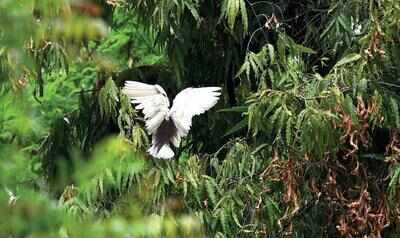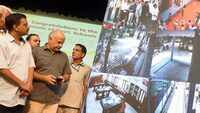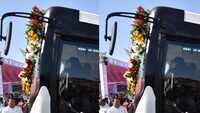
Nagpur: It’s right there, surrounded by concrete, in the middle of a congested locality and bang opposite a shopping mall. On the outside, it looks like a wild overgrowth. For about 128 years, it was a celebrated landmark; after all it saw the world’s first twisting and thinning of cotton strands to produce ring spun yarns.
Today, after 14 years of cessation of this venture, a large part of it is again seeing twisting and thinning. Not of cotton strands this time but twigs and grass. Long-legged freshwater predators have chosen this iconic site as their home, where they are busy building hundreds of nesting colonies.
Despite losing the Empress Mill, it isn’t any run-of-the-mill land. It is home to a variety of herons and various other species, a thriving biodiversity which will all be lost if a road comes up. Sounds similar? Yes, it does seem like a sequel to Bharat Van.
To ascertain the extent of environmental damage that the road project would cause, TOI went to the site with a team of experts including conservationists, environmentalists and members of Punarnava, a consultancy which provides ecological services.
As soon as one enters through the gate opposite Empress Mall, a siege of herons welcome you. They are busy collecting twigs and other materials for building nests. On many Subabul trees, a large number of nests have already found home.
It was purely “by-chance” that this heron colony was discovered in the middle of the urban jungle. “Before submitting objection letters, we decided to inspect the site. We were surprised to find that this is the roosting and nesting site for thousands of birds,” said Prachi Mahurkar, environment activist and member of Punarnava.
According to experts, the Empress Mill site is the only oxygen hub of East Nagpur. “In absence of other dense green cover in the area, birds are choosing to nest here. The biggest advantage is its proximity with Gandhisagar lake. They feed at the lake and then fly here for roosting and nesting,” said Pradyumna Sahasrabhojanee, noted architect and conservationist.
“The only other place in Nagpur where we saw such a large heronry is near RTPS road,” said Amandeep Gupta, a member of Punarnava.
According to honorary wildlife warden of Nagpur Jaydeep Das, the area is the only heron habitat near Gandhisagar lake. “While the entire world including International Union for Conservation of Nature are running heron conservation programme, we are least concerned. Herons play an important role in ecology by controlling insects and other small waterborne creatures,” he said.
Stating that the city has almost lost house sparrows and crows, Das added that it will now lose herons too. “Once you destroy their homes for a road, people will start facing trouble from increasing number of insects. It’s not just the trees that we are cutting but destroying avian species too,” said Das.
Apart from black-crowned night heron, the Mill land also houses cattle egret, intermediate egret, cuckoo, crows, robins, drongos, common myna and many others birds.
The most prominent sign of the area being a healthy biodiversity impact is the natural regeneration of various tree species and climbers. “We have found large-scale regeneration of native plants across the area. Big native climbers are shaping the habitat. It is evident that biodiversity is flourishing here,” said green activist Madhuri Kanetkar.
Explaining the ecological value of the area, Mahurkar said, “Cutting hundreds of trees here would not just mean losing green cover but also snatching away habitat of thousands of species of birds, animals, insects and microorganisms. It would eventually disturb the entire food chain.”
The problem is not just the 15-meter-wide road. “Along with it will come encroachments, more buildings and human disturbance which will kill the thriving biodiversity here,” said Sahasrabhojanee.
A day after submitting over 650 objection letters against the proposed road through lush green area of Empress Mill, citizens filed another 200 letters at the Nagpur Municipal Corporation's (NMC) garden department on Tuesday.
Will the authorities listen to the birds’ call? As we always say, only the road will tell.
Today, after 14 years of cessation of this venture, a large part of it is again seeing twisting and thinning. Not of cotton strands this time but twigs and grass. Long-legged freshwater predators have chosen this iconic site as their home, where they are busy building hundreds of nesting colonies.
Despite losing the Empress Mill, it isn’t any run-of-the-mill land. It is home to a variety of herons and various other species, a thriving biodiversity which will all be lost if a road comes up. Sounds similar? Yes, it does seem like a sequel to Bharat Van.
To ascertain the extent of environmental damage that the road project would cause, TOI went to the site with a team of experts including conservationists, environmentalists and members of Punarnava, a consultancy which provides ecological services.
As soon as one enters through the gate opposite Empress Mall, a siege of herons welcome you. They are busy collecting twigs and other materials for building nests. On many Subabul trees, a large number of nests have already found home.
It was purely “by-chance” that this heron colony was discovered in the middle of the urban jungle. “Before submitting objection letters, we decided to inspect the site. We were surprised to find that this is the roosting and nesting site for thousands of birds,” said Prachi Mahurkar, environment activist and member of Punarnava.
According to experts, the Empress Mill site is the only oxygen hub of East Nagpur. “In absence of other dense green cover in the area, birds are choosing to nest here. The biggest advantage is its proximity with Gandhisagar lake. They feed at the lake and then fly here for roosting and nesting,” said Pradyumna Sahasrabhojanee, noted architect and conservationist.
“The only other place in Nagpur where we saw such a large heronry is near RTPS road,” said Amandeep Gupta, a member of Punarnava.
According to honorary wildlife warden of Nagpur Jaydeep Das, the area is the only heron habitat near Gandhisagar lake. “While the entire world including International Union for Conservation of Nature are running heron conservation programme, we are least concerned. Herons play an important role in ecology by controlling insects and other small waterborne creatures,” he said.
Stating that the city has almost lost house sparrows and crows, Das added that it will now lose herons too. “Once you destroy their homes for a road, people will start facing trouble from increasing number of insects. It’s not just the trees that we are cutting but destroying avian species too,” said Das.
Apart from black-crowned night heron, the Mill land also houses cattle egret, intermediate egret, cuckoo, crows, robins, drongos, common myna and many others birds.
The most prominent sign of the area being a healthy biodiversity impact is the natural regeneration of various tree species and climbers. “We have found large-scale regeneration of native plants across the area. Big native climbers are shaping the habitat. It is evident that biodiversity is flourishing here,” said green activist Madhuri Kanetkar.
Explaining the ecological value of the area, Mahurkar said, “Cutting hundreds of trees here would not just mean losing green cover but also snatching away habitat of thousands of species of birds, animals, insects and microorganisms. It would eventually disturb the entire food chain.”
The problem is not just the 15-meter-wide road. “Along with it will come encroachments, more buildings and human disturbance which will kill the thriving biodiversity here,” said Sahasrabhojanee.
A day after submitting over 650 objection letters against the proposed road through lush green area of Empress Mill, citizens filed another 200 letters at the Nagpur Municipal Corporation's (NMC) garden department on Tuesday.
Will the authorities listen to the birds’ call? As we always say, only the road will tell.
World Cup 2019
Trending Topics
LATEST VIDEOS
More from TOI
Navbharat Times
Featured Today in Travel
Quick Links
Lok Sabha Election Schedule 2019Lok Sabha Election NewsDelhi Capitals teamMI team 2019Rajasthan Royals 2019RCB team 2019Maharashtra Lok Sabha ConstituenciesBJP Candidate ListBJP List 2019 TamilnaduShiv Sena List 2019AP BJP List 2019Mamata BanerjeeBJP List 2019 MaharashtraPriyanka GandhiBJP List 2019 KarnatakaAMMK Candidate List 2019BJP List 2019 WBLok Sabha Elections in Tamil NaduBSP List 2019 UPNews in TamilLok Sabha Poll 2019Satta Matka 2018PM ModiMahagathbandhanNagpur BJP Candidate ListChandrababu NaiduTamil Nadu ElectionsUrmila MatondkarNews in TeluguMadras High CourtTejashwi YadavArvind KejriwalTejasvi SuryaPawan KalyanArvind KejriwalYogi AdityanathJaya PradaSatta King 2019Srinagar encounter
Get the app







